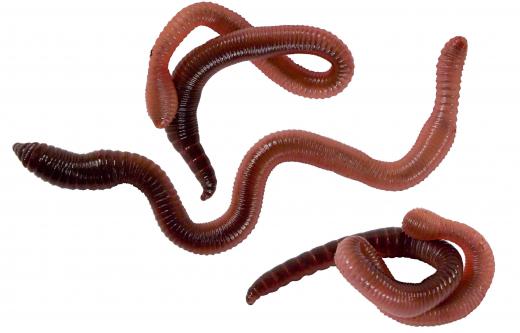What are Annelids?
 Michael Anissimov
Michael Anissimov
Annelids, members of phylum Annelida, are a group of worms with about 18,000 species, including the familiar earthworm. Annelids have a fossil record stretching back to the Cambrian, and are distinguished from other organisms called "worms" by the presence of a body cavity (coelom) and true segmentation, both of which give them an evolutionary advantage. Annelids are the most complex organisms capable of full regeneration if they are cut in half, and indeed are able to reproduce asexually by releasing an end of their tail, which subsequently grows into a complete organism. Annelids can also reproduce sexually.
There are four classes of annelids: polychaete worms, marine annelids which make up the majority of all species (more than 10,000), clitellates, a large group which includes leeches and earthworms, haplodrils, simple marine worms, and myzostomids, small parasites of sea lilies. Polychaetes are characterized by lateral outgrowths called parapodia, which are covered in chitinous bristles called chaetae, giving them their name. The parapodia are used for respiration, locomotion, burrowing, and to create a feeding current.

On land, annelids perform a critical role in breaking down organic matter to create rich soil. As such, earthworms are highly valued by farmers, and there are even industrial worm farms used to break down organic material en masse. Unique among organisms, earthworms have a mouth that connects directly to the anus without an intermediate stomach. This allows them to continually eat and excrete waste as they burrow through the soil. As such, they may be considered terrestrial filter feeders.
Though earthworms are more familiar to us among the annelids, some of the most impressive members of the group are polychaetes, found in the ocean. One polychaete, the Pompeii worm (Alvinella pompejana) lives in hydrothermal vents in the Pacific ocean, where it is exposed to temperatures of up to 80°C (176°F). As such, the Pompeii worm is the most heat-tolerant macroscopic organism known. It is, however, difficult to study, because the organism lives at such depths and is so fragile that it does not survive the decompression from being brought to the surface.
Another interesting polychaete is Hesiocaeca methanicola, the only known animal that can inhabit methane clathrates, extensive methane deposits locked in ice on certain parts of the ocean floor. It is thought that these worms consume bacteria which feed on the methane.
AS FEATURED ON:
AS FEATURED ON:











Discussion Comments
@Kristee – Yes, the men in my family used to dig up earthworms to use when fishing. I found it disgusting, but they were so happy about the free bait.
I hated watching them hook the worm. Piercing a living thing just seems so brutal, as does dangling it for a fish to devour from below.
They also used leeches as bait sometimes. Leeches are annelids, too.
You have to be careful not to get them on you, because they suck blood. You can't feel it, either, because an anesthetic that comes out of their bodies numbs your skin. I refused to be on the boat with them when they were using leeches because of this.
@feasting – I like finding earthworms in my garden, because I know it means that the soil is rich. They really do make the dirt more nutritious for flowers.
If you'll notice, you usually find earthworms in really rich, dark earth. This is no coincidence. The earth is good because the worms are there.
Does anyone know if these annelids are what fishermen use as bait? I've heard of people digging in the dirt for worms to fish with, but I don't know if they are looking for earthworms or some other type of worm.
Earthworms are disgusting to me. They have such slimy, wiggly bodies, and whenever I have to dig, I encounter a lot of them.
What's really gross is when my shovel splits one in two. I feel bad for them when this happens, but it is still really hard to look at the gross worm wiggling all around.
The Pompeii worm is really odd looking. I saw a photo of one, and it appeared to be covered in hair!
I read that it collects bacteria on this hair and eats them. The worm sits in hot spots in vent chimneys well over a hundred degrees, but its head stays above in cooler water.
I found all this fascinating. It's neat to learn about and view photos of something that will likely never make it to the surface to be seen up close.
All annelids are segmented. That's the basic definition of an annelid.
Annelids are worms with soft bodies,which are sometimes segmented, and they have no legs.
Post your comments